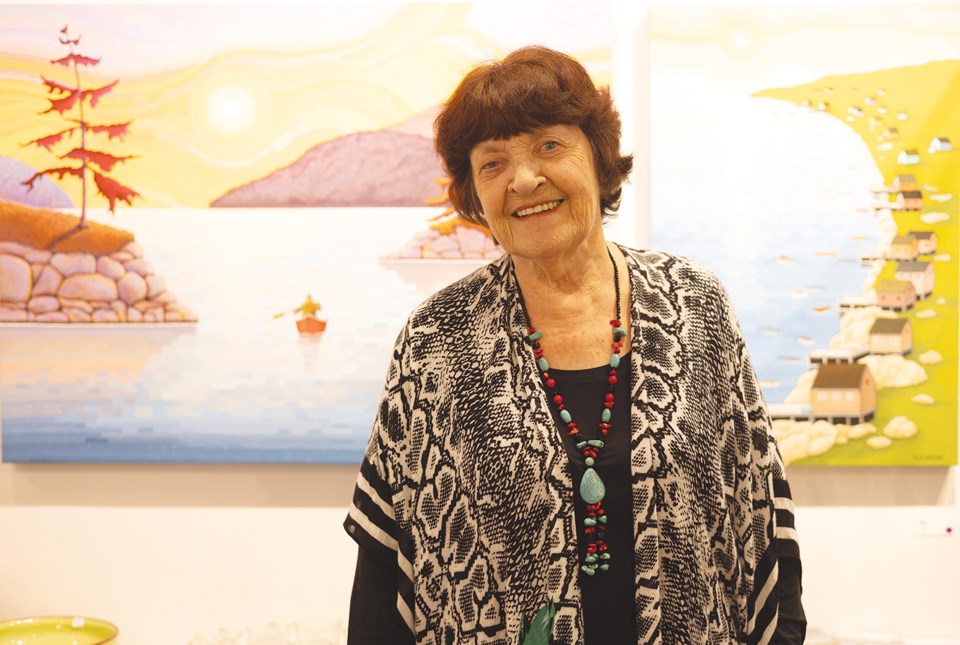A month-long celebration of paintings by Elizabeth Evans provides a survey of the Montreal-born artist’s creative breadth while highlighting her genius for innovation. Evans, a professional painter for six decades, has lived in Gibsons since 2009. Last weekend the town’s One Flower One Leaf Gallery opened an eponymous exhibition spanning Evans’s career (subtitled, definitively, “The Exhibition”).
Gallery owner Grace Unopia had originally assigned a single wall of her gallery to Evans’s output. Above the cash register, she made room for the painting that in 2022 earned Evans the title of Artist of the Year by the Nature Trust of British Columbia. (The Intruder depicts a swampland standoff between three charismatic Canada geese.)
After a visit to Evans’s home and studio, Unopia expanded the exhibition to include scores of works, covering every available surface. “She even took stuff off my walls,” laughed Evans. Although she normally paints generously proportioned scenes in acrylics, the show’s deadline also spurred a frenzy of smaller canvases that encapsulate quintessential Canadian landscapes.
Evans was raised in Quebec’s eastern townships, and snug hamlets populated by bright-sided houses appear regularly in her images. The compact paintings are inspired by real-life locations, from rural Tangier in Nova Scotia to Vancouver Island’s Tofino. Capilano Moonlight, a uniquely muted evocation of crepuscular light on cedar-lined ridges, is a rare departure from the dazzling lavender and ochre skies that dominate most of her vistas.
The influence of her one-time mentor, Group of Seven founder Arthur Lismer, is evident in Evans’s fascination with rippling firmaments bounded by bark and stone. “[I paint] water, and its reflections, wherever it is,” she said, “because I’m an Aquarius. Especially on the East Coast — with the houses and the tiny little boats; I know they’re a busy people and they’re trying to make a living — but for me, when the sun’s out it’s just charming. Even the winter themes go back to my childhood in Quebec. I paint memories, and I paint everything from my head.”
Lismer, her teacher and mentor, died in 1969 — only five years after his protégé’s inaugural exhibition at the Gallerie Gauvreau on Sherbrooke Street in Montreal.
Evans developed a distinctive style called Brickilism. The technique builds on the pointillism of Georges Seurat by using distinct bricks of colour to compose shapes and fields of colour. Adjusting the size and orientation of each brick, Evans projects panoramas with a particular force of visual gravity. In Idyllic Passage, a solo canoe paddler circuits islets under a florid sky, the sea’s mottled blues fade into iridescent whiteness among far-off headlands. In a bucolic rendition of an inland orchard, the earth itself is composed of sunburnt ovoids whose diminishing proportions lead the eye to distant hillocks.
The display also includes Evans’s whimsical paintings of cherubic skaters gliding on frozen ponds and a selection of her canine characters (a bloodhound wearing a deerstalker puffs sagely on a pipe; a cigar-smoking pug spreads a royal flush on a green baize tabletop).
“I can be working on one painting and I’m so into it. But while I’m into it, something comes out of that painting and feeds onto something new,” explained Evans. “And I have to stop for a minute, make notes and then leave the notes and go back to where I was and continue what I’m pursuing. It never stops. I go to bed at night and I’m still seeing images.”
Elizabeth A. Evans: The Exhibition continues at the One Flower One Leaf Gallery until Dec. 29.



